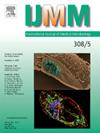Co-transcribed genes SA1833-SA1832 promote persister formation by regulating the transcription of holin-like gene lrgA in methicillin-resistant Staphylococcus aureus strain N315
IF 3.6
3区 医学
Q1 MICROBIOLOGY
引用次数: 0
Abstract
Staphylococcus aureus, a facultative anaerobic gram-positive bacterial pathogen, has posed major threat to public health worldwide. Upon S. aureus infection, the host immune system is activated for clearance. However, intracellular S. aureus, which remains viable for an extended time, has evolved the ability to escape from immune response and extracellular antibiotics. One of possible strategies is the formation of persisters. Persistence is one of the major causes of S. aureus relapse infection but the underlying mechanisms remain obscure. Here, we identified two co-transcribed genes SA1833-SA1832 that are involved in persister formation in S. aureus. Dysfunction of SA1833 and/or SA1832 significantly reduces persister formation in the presence of ceftizoxime. Additionally, we found that the expression of SA1833 and SA1832 under the induction of oxidative stress and SOS response is strictly regulated by the LexA-RecA pathway. Interestingly, SA1833-SA1832 contributes to persister formation in an lrgA-dependent manner. Moreover, the mouse RAW264.7 macrophage infection model indicated that disrupting SA1833-SA1832 inhibits S. aureus from infecting macrophages and impairs its ability to survive in the intracellular environment.
共转录基因 SA1833-SA1832 通过调节耐甲氧西林金黄色葡萄球菌菌株 N315 中 holin-like 基因 lrgA 的转录,促进顽固菌的形成。
金黄色葡萄球菌是一种兼性厌氧革兰阳性细菌病原体,对全球公共卫生构成重大威胁。感染金黄色葡萄球菌后,宿主的免疫系统会被激活以清除病菌。然而,细胞内的金黄色葡萄球菌可长期存活,已进化出逃避免疫反应和细胞外抗生素的能力。其中一种可能的策略就是形成持久菌。持续存在是金黄色葡萄球菌复发感染的主要原因之一,但其潜在机制仍不清楚。在这里,我们发现了两个共同转录的基因 SA1833-SA1832,它们参与了金黄色葡萄球菌中持久体的形成。在头孢唑肟存在的情况下,SA1833和/或SA1832的功能障碍会显著减少顽固菌的形成。此外,我们还发现,在氧化应激和 SOS 反应的诱导下,SA1833 和 SA1832 的表达受到 LexA-RecA 通路的严格调控。有趣的是,SA1833-SA1832 是以一种依赖 lrgA 的方式促进宿主形成的。此外,小鼠 RAW264.7 巨噬细胞感染模型表明,破坏 SA1833-SA1832 可抑制金黄色葡萄球菌感染巨噬细胞,并损害其在细胞内环境中的生存能力。
本文章由计算机程序翻译,如有差异,请以英文原文为准。
求助全文
约1分钟内获得全文
求助全文
来源期刊
CiteScore
9.70
自引率
0.00%
发文量
18
审稿时长
45 days
期刊介绍:
Pathogen genome sequencing projects have provided a wealth of data that need to be set in context to pathogenicity and the outcome of infections. In addition, the interplay between a pathogen and its host cell has become increasingly important to understand and interfere with diseases caused by microbial pathogens. IJMM meets these needs by focussing on genome and proteome analyses, studies dealing with the molecular mechanisms of pathogenicity and the evolution of pathogenic agents, the interactions between pathogens and host cells ("cellular microbiology"), and molecular epidemiology. To help the reader keeping up with the rapidly evolving new findings in the field of medical microbiology, IJMM publishes original articles, case studies and topical, state-of-the-art mini-reviews in a well balanced fashion. All articles are strictly peer-reviewed. Important topics are reinforced by 2 special issues per year dedicated to a particular theme. Finally, at irregular intervals, current opinions on recent or future developments in medical microbiology are presented in an editorial section.

 求助内容:
求助内容: 应助结果提醒方式:
应助结果提醒方式:


